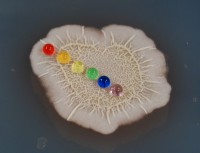Bacterial raincoat discovery paves way to better crop protection

Fresh insights into how bacteria protect themselves – by forming a waterproof raincoat – could help develop improved products to protect plants from disease.
Researchers have discovered how communities of beneficial bacteria form a waterproof coating on the roots of plants, to protect them from microbes that could potentially cause plant disease. Their insights could lead to ways to control this shield and improve its efficiency, which could help curb the risk of unwanted infections in agricultural or garden plants, the team says.
Scientists at the Universities of Edinburgh and Dundee studied the protective film formed by the common soil bacterium Bacillus subtilis. They found it incorporates proteins that change shape as they reach the film surface. This exposes an impervious surface on the protein molecules, enabling them to slot together like a jigsaw puzzle, to protect bacteria underneath. The film is able to repel water – which means other potentially harmful molecules also bounce off. Researchers say that being able to control the production of the biofilm in agricultural products could enable improved protection for plants.
The study, funded by the Engineering and Physical Sciences Research Council and the Biotechnology and Biological Sciences Research Council, is published in Proceedings of the National Academy of Sciences. The team behind the finding plans to research further applications for their discovery.
“Such a controlled shape change in a protein is unusual. This protein only responds in exactly the right way and in the right place. It protects microbes from the outside world, but the ability to control the creation of a water-repellent film has many possible applications.” Prof. Cait MacPhee, School of Physics and Astronomy
Our findings highlight one of the amazing mechanisms that bacteria have evolved to provide protection from changes in their environment. It also demonstrates the advances that can be made when biologists and physicists work together on a problem of mutual interest.” Dr Nicola Stanley-Wall, Division of Molecular Microbiology, University of Dundee
Watch an animation showing how bacteria protect themselves by forming a water-repellent raincoat: https://www.youtube.com/watch?v=hO3HjtJ1TsE

